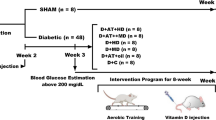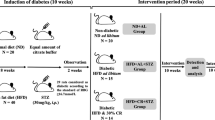Abstract
Aims
Glypican-4 (GPC-4) is a novel adipomyokine that enhances insulin signaling. Glycosylphosphatidylinositol-specific phospholipase D (GPLD1) is thought to release GPC-4 and is itself an insulin-regulated enzyme. Beneficial effects of exercise training and chamomile flowers extract (CFE) are shown through activation of PPARγ, which is a promising drug target in diabetes and associated with GPC-4 synthesis. This study investigated the effects of 14-week treadmill running and CFE on serum GPC-4, GPLD1, and insulin levels in streptozotocin–nicotinamide (STZ–NA)-induced diabetic rats.
Methods
Thirty-two STZ–NA-induced diabetic male Wistar rats were randomly assigned to four groups: control (C), training (T), CFE treatment (CFE), and training plus CFE treatment (TCFE) groups. The training groups were exercised on treadmill 5 days/week and the treating groups were fed with 200 mg/kg/day CFE in drinking water for 14 weeks. Finally, serum GPC-4, GPLD1, and insulin levels were analyzed via sandwich ELISA.
Results
Compared to the control group, serum insulin levels were significantly higher in the T, CFE, and TCFE groups (p < 0.05, p < 0.05, p < 0.01, respectively), while OGTT and serum GPLD1 levels were significantly lower in the T, CFE, and TCFE groups (all p < 0.001). Changes in serum GPC-4 levels were not significant. Serum GPLD1 levels were negatively correlated with insulin levels and HOMA-IS (both p < 0.001).
Conclusions
This study suggests that endurance training and CFE may downregulate serum GPLD1 levels in STZ–NA-induced diabetic rats, which associate with the serum insulin profile. However, the results show that endurance training and CFE may not cause serum GPC-4 adaptation in STZ–NA-induced diabetic rats.





Similar content being viewed by others
References
Iozzo RV, Schaefer L (2015) Proteoglycan form and function: A comprehensive nomenclature of proteoglycans. Matrix Biol 42:11–55
Mitchell F (2012) Obesity: Glypican-4: role in insulin signaling. Nat Rev Endocrinol 8:505
Tamori Y, Kasuga M (2013) Glypican-4 is a new comer of adipokines working as insulin sensitizer. J Diabetes Investig 4:250–251
Ussar S, Bezy O, Blüher M, Kahn CR (2012) Glypican-4 enhances insulin signaling via interaction with the insulin receptor and serves as a novel adipokine. Diabetes 61:2289–2298
Song HH, Filmus J (2002) The role of glypicans in mammalian development. Biochem Biophys Acta 1573:241–246
Kristiansen S, Richter EA (2002) GLUT4-containing vesicles are released from membranes by phospholipase D cleavage of a GPI anchor. Am J Physiol Endocrinol Metab 283:374–382
Deeg MA, Bowen RF, Williams MD, Olson LK, Kirk EA, LeBoeuf RC (2001) Increased expression of GPI-specific phospholipase D in mouse models of type 1 diabetes. Am J Physiol Endocrinol Metab 281:147–154
Schofield JN, Stephens JW, Hurel SJ, Bell KM, deSouza JB, Rademacher TW (2002) Insulin reduces serum glycosylphosphatidylinositol phospholipase D levels in human type I diabetic patients and streptozotocin diabetic rats. Mol Genet Metab 75:154–161
Qin W, Liang YZ, Qin BY, Zhang JL, Xia N (2016) The clinical significance of glycoprotein phospholipase D levels in distinguishing early stage latent autoimmune diabetes in adults and type 2 diabetes. PLoS ONE 11:1–15
Raikwar ND, Bowen-Deeg RF, Du XS, Low MG, Deeg MA (2010) Glycosylphosphatidylinositol-specific phospholipase D improves glucose tolerance. Metab Clin Exp 59:1413–1420
Li K, Xu X, Hu W et al (2014) Glypican-4 is increased in human subjects with impaired glucose tolerance and decreased in patients with newly diagnosed type 2 diabetes. Acta Diabetol 51:981–990
Oh K-J, Lee DS, Kim WK, Han BS, Lee SC, Bae KH (2017) Metabolic adaptation in obesity and type II diabetes: myokines, adipokines and hepatokines. Int J Mol Sci 18:1–31
Liu L, Gu H, Zhao Y, An L, Yang J (2014) Glypican 4 may be involved in the adipose tissue redistribution in high-fat feeding C57BL/6J mice with peroxisome proliferators-activated receptor γ agonist rosiglitazone treatment. Exp Ther Med 8:1813–1818
Wang L, Waltenberger B, Pferschy-Wenzig EM et al (2014) Natural product agonists of peroxisome proliferator-activated receptor gamma (PPARγ): a review. Biochem Pharmacol 92:73–89
Rashmi S, Shilpy S (2016) Herbs and botanical ingredients with beneficial effects on blood sugar levels in pre-diabetes. Herb Med Open Access 2:1–11
Kelleni MT (2016) Chamomile tea potentials in prevention and amelioration of type 2 diabetes mellitus. J Diabetes Metab 7:1
Sebai H, Jabri MA, Souli A et al (2014) Antidiarrheal and antioxidant activities of chamomile (Matricaria recutita L.) decoction extract in rats. J Ethnopharmacol 152:327–332
Zemestani M, Rafraf M, Asghari-Jafarabadi M (2016) Chamomile tea improves glycemic indices and antioxidants status in patients with type 2 diabetes mellitus. J Nutr 32:66–72
Kato A, Minoshima Y, Yamamoto J, Adachi I, Watson AA, Nash RJ (2008) Protective effects of dietary chamomile tea on diabetic complications. J Agric Food Chem 56:8206–8211
Weidner C, Wowro SJ, Rousseau M et al (2013) Antidiabetic effects of chamomile flowers extract in obese mice through transcriptional stimulation of nutrient sensors of the peroxisome proliferator-activated receptor (PPAR) family. PLoS ONE 8:1–16
Butcher L, Backx K, Webb R, Thomas A, Roberts A, Morris K (2009) Low-intensity exercise regulates PPAR-γ activity: a molecular rationale for diabetes prevention? In: Abstracts of the 3rd international congress on prediabetes and the metabolic syndrome, pp 71–72
Heidarianpour A, Sadeghian E, Gorzi A, Nazem F (2011) The influence of oral magnesium sulfate on skin microvasculature blood flow in diabetic rats. Biol Trace Elem Res 143:344–350
Ghasemi A, Khalifi S, Jedi S (2014) Streptozotocin–nicotinamide-induced rat model of type 2 diabetes (review). Acta Physiol Hung 101:408–420
Ghanbari-Niaki A, Farshidi Z, Fathi R (2010) Effects of different endurance training intensities on resting levels of skeletal muscle and liver glycogen concentrations in male rats. Int J Endocrinol Metab 8:79–81
Azmir J, Zaidul ISM, Rahman MM et al (2013) Techniques for extraction of bioactive compounds from plant materials: a review. J Food Eng 117:426–436
Hosseinpour M, Mobini-Dehkordi M, Saffar B, Teimori H (2013) Antiproliferative effects of Matricaria chamomilla on Saccharomyces cerevisiae. J HerbMed Pharmacol 2:49–51
Bowe JE, Franklin JZ, Hauge-Evans AC, King AJ, Persaud SJ, Jones PM (2014) Assessing glucose homeostasis in rodent models. J Endocrinol 222:13–25
Lasheen NN (2015) Pancreatic functions in high salt fed female rats. Physiol Rep 3:1–13
Du Y, Wei T (2014) Inputs and outputs of insulin receptor. J Protein Cell 5:203–213
Nazem F, Farhangi N, Neshat-Gharamaleki M (2015) Beneficial effects of endurance exercise with Rosmarinus officinalis Labiatae leaves extract on blood antioxidant enzyme activities and lipid peroxidation in streptozotocin-induced diabetic rats. Can J Diabetes 39:229–234
Sennott J, Morrissey J, Standley PR, Broderick TL (2008) Treadmill exercise training fails to reverse defects in glucose, insulin and muscle GLUT4 content in the db/db mouse model of diabetes. Pathophysiology 15:173–179
Ito D, Cao P, Kakihana T et al (2015) Chronic running exercise alleviates early progression of nephropathy with upregulation of nitric oxide synthases and suppression of glycation in zucker diabetic rats. PLoS ONE 10:1–21
Cerf ME (2013) Beta cell dysfunction and insulin resistance. Front Endocrinol 4:1–12
Choi SB, Jang JS, Hong SM, Jun DW, Park S (2006) Exercise and dexamethasone oppositely modulate β-cell function and survival via independent pathways in 90% pancreatectomized rats. J Endocrinol 190:471–482
Tahara A, Matsuyama-Yokono A, Nakano R, Someya Y, Shibasaki M (2008) Hypoglycaemic effects of antidiabetic drugs in streptozotocin–nicotinamide-induced mildly diabetic and streptozotocin-induced severely diabetic rats. Basic Clin Pharmacol Toxicol 103:560–568
Panda S, Kar A (2007) Apigenin (4′,5,7-trihydroxyflavone) regulates hyperglycaemia, thyroid dysfunction and lipid peroxidation in alloxan-induced diabetic mice. J Pharm Pharmacol 59:1543–1548
Ramesh B, Pugalendi KV (2006) Antihyperglycemic effect of umbelliferone in streptozotocin-diabetic rats. J Med Food 9:562–566
Teixeira-Lemos E, Nunes S, Teixeira F, Reis F (2011) Regular physical exercise training assists in preventing type 2 diabetes development: focus on its antioxidant and anti-inflammatory properties. Cardiovasc Diabetol 10:1–15
Zhang X, Wang L, Song Y (2016) Dietary antioxidant vitamins and flavonoids and type 2 diabetes: a review of current epidemiologic evidence. N Am J Med Sci 9:12–16
O’Brien KD, Pineda C, Chiu WS, Bowen R, Deeg MA (1999) Glycosylphosphatidylinositol-specific phospholipase D is expressed by macrophages in human atherosclerosis and colocalizes with oxidation epitopes. Circulation 99:2876–2882
Jin JK, Jang B, Tae Jin H et al (2015) Phosphatidylinositol-glycan-phospholipase D is involved in neurodegeneration in prion disease. PLoS ONE 10:1–11
Gleeson M, Bishop NC, Stensel DJ, Lindley MR, Mastana SS, Nimmo MA (2011) The anti-inflammatory effects of exercise: mechanisms and implications for the prevention and treatment of disease. J Nat Rev Immunol 11:1–10
Yoo HJ, Hwang SY, Cho GJ et al (2013) Association of Glypican-4 with body fat distribution, insulin resistance, and nonalcoholic fatty liver disease. J Clin Endocrinol Metab 98:2897–2901
Traister A, Shi W, Filmus J (2008) Mammalian Notum induces the release of glypicans and other GPI-anchored proteins from the cell surface. Biochem J 410:503–511
Zhu HJ, Pan H, Cui Y et al (2014) The changes of serum Glypican4 in obese patients with different glucose metabolism status. J Clin Endocrinol Metab 99:2697–2701
Acknowledgements
This research was supported by Bu-Ali Sina University.
Author information
Authors and Affiliations
Corresponding author
Ethics declarations
Conflict of interest
The authors declare that they have no conflict of interest.
Ethical approval
Animal experimental procedures were in accordance with institutional guidelines and approved by the ethical committee of laboratory animals Care at Bu-Ali Sina University (BASU), Hamedan, Iran.
Human and Animal rights
No human studies were carried out by the authors for this article.
Informed consent
For this type of study formal consent is not required.
Additional information
Managed by Antonio Secchi.
Rights and permissions
About this article
Cite this article
Abdolmaleki, F., Heidarianpour, A. The response of serum Glypican-4 levels and its potential regulatory mechanism to endurance training and chamomile flowers’ hydroethanolic extract in streptozotocin–nicotinamide-induced diabetic rats. Acta Diabetol 55, 935–942 (2018). https://doi.org/10.1007/s00592-018-1173-4
Received:
Accepted:
Published:
Issue Date:
DOI: https://doi.org/10.1007/s00592-018-1173-4




